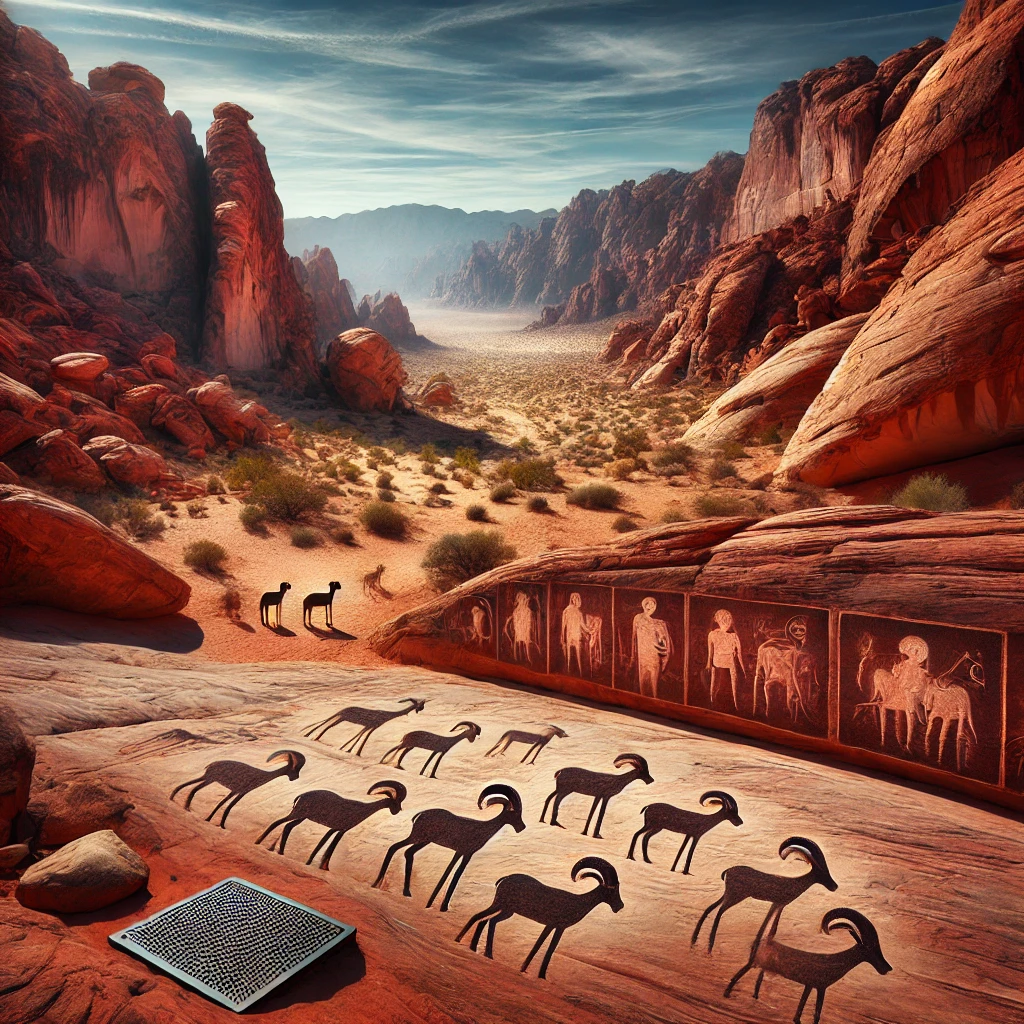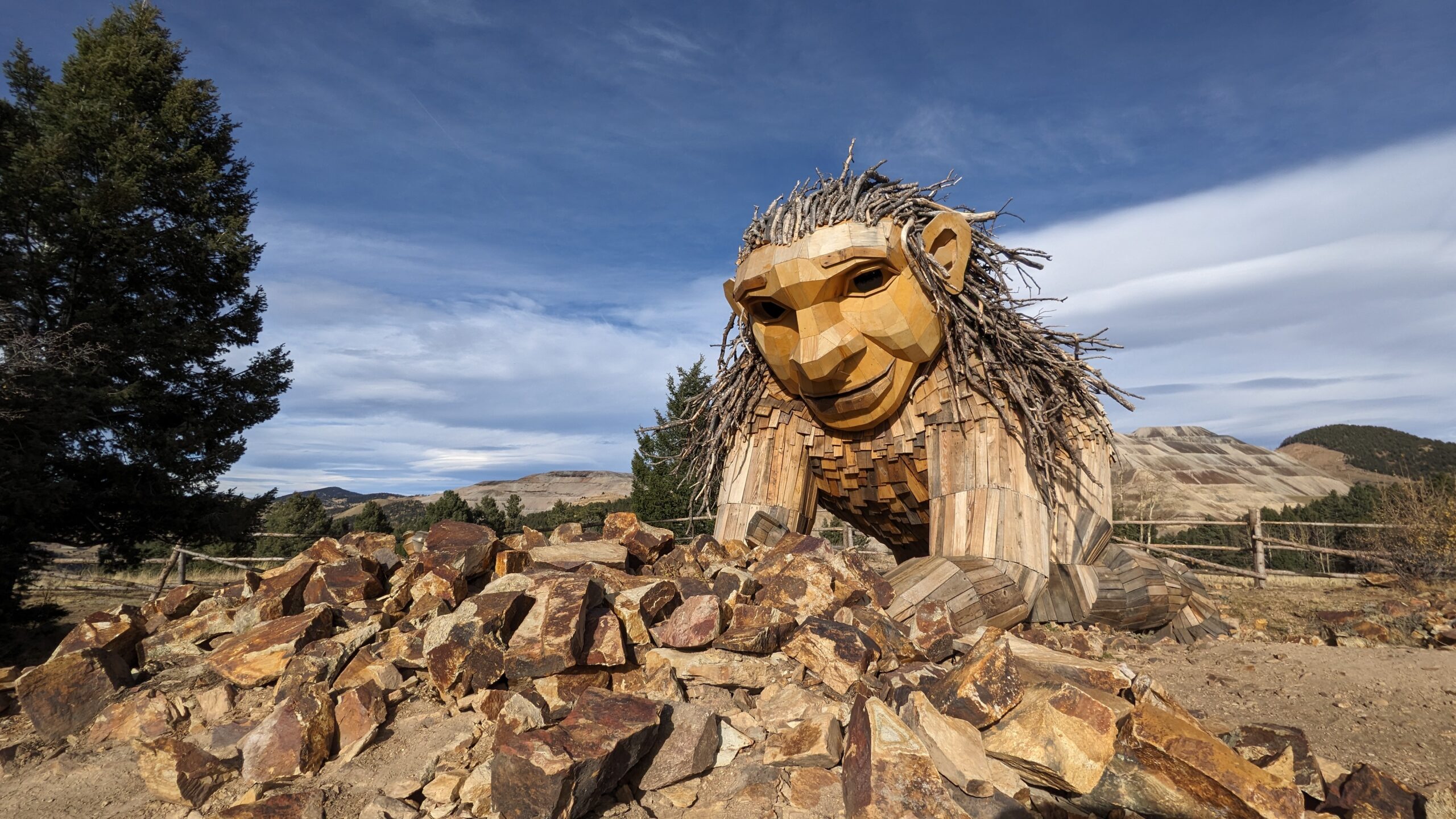We explored the remarkable Valley of Fire State Park in Nevada, a landscape that’s famed for its stunning red rock formations and ancient petroglyphs. We camped at the park’s campground, giving us a front-row seat to the fiery hues of the desert as the sun set over the horizon. It’s easy to see why this place attracts so many visitors, with its vibrant colors and dramatic geology. But as we ventured through the park, a few things made us pause and reflect—particularly the curious rumors surrounding the authenticity of the petroglyphs, the presence of hidden infrastructure beneath the sands, and the unexpected blend of ancient carvings with modern graffiti.
During our drive through the park, we couldn’t help but notice something that further fueled our skepticism: many major cable or pipe pit lids and kiosks dotted the sides of the road. Some of these areas were marked with signs that read “Do Not Enter,” making it clear that parts of this desert landscape were more industrial than they appeared. We also noticed modern graffiti scrawled alongside the petroglyphs, with some markings resembling doodles of the bighorn sheep icons found in the ancient carvings. It left us questioning whether the untouched beauty of the park was indeed natural, or if hidden infrastructure and modern hands had altered the landscape more than we realized.
We took on two of the park’s most popular hikes—Mouse Tank Trail and Rainbow Vista Trail—both offering an up-close look at the red rock formations and petroglyphs scattered across the park. We marveled at the Arch Rock and Balanced Rock formations, which look as though nature defied gravity to create them. We also stopped at the visitor center, where our little one proudly earned a Junior Ranger badge, adding to the sense of adventure and discovery. But amidst the natural beauty, we couldn’t help but wonder: Is everything as natural as it seems?
Camping in the Valley of Fire
Camping at Valley of Fire was an experience unlike any other. Nestled in a campsite surrounded by towering red rocks, we felt both awe-inspired and dwarfed by the geological formations. The campground is well-maintained, and it offers a serene place to relax after a day of hiking. As night fell, the sky above us became a blanket of stars, reminding us just how far from civilization we were—or so it seemed.
Our evening was made even more memorable when a herd of desert bighorn sheep wandered through our campsite and past our trailer. It was an incredible sight—these wild animals moving gracefully through the desert. However, our beagle, Sniffy, was less impressed. He barked at them from the trailer, sending the sheep scattering. While it was an amusing moment, it also reminded us of the park’s delicate balance between nature and human presence.
While the park feels remote and untouched, part of us couldn’t shake the idea that something might be lurking beneath the surface. The presence of the cable and pipe infrastructure we saw along the roadside certainly hinted at the possibility. With Nevada’s growing population and demand for energy, it’s not entirely far-fetched to think that pipelines or cables could be running underground, discreetly camouflaged by the surrounding desert. It’s easy to imagine that somewhere, just out of sight, lies the infrastructure needed to power the cities and towns nearby.
Mouse Tank and Rainbow Vista Trails: Petroglyphs and Modern Markings
Our hike along Mouse Tank Trail was both beautiful and thought-provoking. The trail winds through a narrow canyon, with petroglyphs carved into the sandstone walls along the way. These ancient drawings are one of the park’s main attractions, believed to have been created by the Ancestral Puebloans thousands of years ago. But as we stood there, admiring the intricate carvings, we couldn’t help but notice modern graffiti scrawled alongside them. It seemed out of place in such a sacred space, yet there it was—crude etchings that sometimes mimicked the iconic bighorn sheep seen in the authentic petroglyphs. Could these modern markings be an attempt to blend in with the ancient artwork, or were they simply acts of vandalism?
While these petroglyphs are said to be a window into a past civilization, their preservation and clarity seem almost too perfect. Could they have been touched up or even created in modern times to enhance the park’s appeal? After all, tourism plays a major role in the local economy, and there’s no denying that these petroglyphs add a certain mystique to the landscape. Skeptics have pointed out that there is no definitive way to date rock carvings, leaving room for speculation that they may not be as ancient as advertised.
Rainbow Vista Trail offered another perspective on the park’s natural beauty, with panoramic views of the multicolored rock formations that give the trail its name. The vibrant reds, pinks, and oranges seem to glow under the desert sun, creating a surreal atmosphere. But even as we took in the scenery, we couldn’t help but wonder what might be hidden beneath the surface. Could there be major pipes or fiber-optic cables running through the landscape, serving the needs of the growing population nearby? The many kiosks and pit lids along the road suggested that there might be more to this desert than meets the eye.
Arch Rock, Balanced Rock, and the Valley’s Mysterious Charm
The natural rock formations of Valley of Fire are nothing short of incredible. Arch Rock, a delicate arch-shaped formation, and Balanced Rock, a massive boulder seemingly defying gravity, both left us in awe. These geological wonders have been shaped by millions of years of wind and water erosion, creating the dramatic landscape we see today.
Yet, as with the petroglyphs, we found ourselves questioning whether everything was as it appeared. The perfectly balanced rocks and arches seemed almost too perfect, too pristine, to be entirely natural. Was this landscape truly untouched by human hands, or had it been subtly altered to create a more dramatic effect for visitors? While we couldn’t find any concrete evidence to support these theories, the nagging feeling remained that not everything was as natural as it seemed.
Earning the Junior Ranger Badge
Our visit wouldn’t have been complete without a stop at the Valley of Fire Visitor Center, where our little one eagerly participated in the Junior Ranger program. It’s a fun and educational way for kids to learn about the park’s history, wildlife, and geology. After completing the activities, they were awarded a Junior Ranger badge—a proud moment that added an extra layer of excitement to our day.
But even at the visitor center, we couldn’t shake the feeling that there might be more going on behind the scenes. With the growing need for infrastructure to support Nevada’s increasing population and the booming tourism industry, it wouldn’t be surprising if there were hidden pipelines or cables running beneath the park, unseen but essential to keeping the region connected and powered.
Valley of Fire: A Natural Wonder or a Carefully Crafted Experience?
As we packed up our campsite and headed out of the park, we reflected on our day at Valley of Fire. There’s no denying that it’s one of the most visually stunning places we’ve ever visited, with its dramatic rock formations and ancient petroglyphs. But there’s also an air of mystery about the place—an undercurrent of doubt that makes you wonder if everything is as it appears. Are the petroglyphs truly ancient, or have they been enhanced to draw in tourists? Is there modern infrastructure lurking beneath the surface of this seemingly untouched landscape?
The sight of so many cable and pipe pit lids and kiosks along the roadsides certainly added to the skepticism. It’s clear that parts of this desert have been altered, though the extent to which the infrastructure impacts the landscape remains unclear. Coupled with the modern graffiti near the petroglyphs, including possible doodles of bighorn sheep, it’s hard to shake the feeling that modern influence is more prevalent here than we initially thought. In the end, Valley of Fire remains a captivating destination, whether you approach it with wide-eyed wonder or a healthy dose of skepticism. It’s a place where natural beauty and human history intersect, leaving visitors with plenty to ponder long after they’ve left the park.
Frequently Asked Questions (FAQ)
- What type of rock formation dominates Valley of Fire State Park?
The park is dominated by Aztec sandstone, known for its vibrant red color, formed from ancient sand dunes over 150 million years ago. - Can I take my dog to Valley of Fire State Park?
Yes, leashed dogs are welcome throughout the park, including on trails and at campsites. Be cautious of hot surfaces and desert wildlife. - Can I light a campfire at Valley of Fire State Park?
Campfires are allowed only in designated fire rings at developed campgrounds. Fire restrictions may apply seasonally, so check with park staff first. - Is there modern infrastructure like pipelines or cables in the park?
While not officially documented, visitors have reported seeing pit lids and kiosks that suggest underground utilities may run through or near the park. - Are the petroglyphs in Valley of Fire State Park real?
Most are considered authentic, but skepticism exists due to their clarity and proximity to visitor areas. Some graffiti has also appeared nearby. - What are the best hikes in Valley of Fire State Park?
Popular hikes include Mouse Tank Trail, Rainbow Vista, White Domes Trail, and Fire Wave—all offering unique views and geological features. - Where can I see bighorn sheep in the park?
Desert bighorn sheep are often spotted near the campgrounds, along scenic roads, and on early morning or late afternoon hikes. - Is Valley of Fire State Park suitable for kids?
Yes, the park has short trails, fun rock formations to explore, and a Junior Ranger program that children can complete at the visitor center. - How hot does it get in Valley of Fire?
Summer temperatures can exceed 40°C (104°F). Always bring water, wear sun protection, and avoid hiking in extreme heat. - Do I need a reservation to camp at Valley of Fire?
Some campsites are first-come, first-served, while others can be reserved online. It’s recommended to book ahead during peak season.




